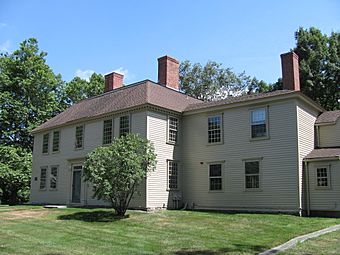Golden Ball Tavern facts for kids
|
Golden Ball Tavern Museum
|
|
|
U.S. Historic district
Contributing property |
|

Golden Ball Tavern Museum
|
|
| Location | 662 Boston Post Road, Weston, Massachusetts |
|---|---|
| Area | 6.3 acres (2.5 ha) |
| Built | 1768 |
| Architectural style | Georgian |
| Part of | Boston Post Road Historic District (ID83009783) |
| NRHP reference No. | 72000141 |
Quick facts for kids Significant dates |
|
| Added to NRHP | September 28, 1972 |
| Designated CP | February 11, 1983 |
The Golden Ball Tavern is a very old building in Weston, Massachusetts. It was built way back in 1768. This building is a great example of a style called Georgian architecture. It was once a busy inn where people could stay and eat. The tavern was also important during the American Revolution because its owner, Isaac Jones, was a Loyalist. This means he supported the British King. Today, the Golden Ball Tavern is a museum where you can learn about its history. It was added to the National Register of Historic Places in 1972.
Contents
What Does the Tavern Look Like?
The Golden Ball Tavern is located on the south side of Boston Post Road. It is close to the center of Weston. This building is made of wood and has two stories. The main part of the building has a special roof called a hip roof. Its outside walls are covered with wooden clapboards.
Different Sections of the Building
The tavern has a two-story section that sticks out from the main part. This section might even be an older house that was added on. There is also a smaller, one-story section on the other side. The main door is in the middle of the front of the building. It has simple columns on each side and a fancy decorated edge above it.
The Old Barn
The property also includes an old barn. People believe this barn was built around the same time as the main house. It helps show what a busy tavern property would have looked like long ago.
A Glimpse into the Past
The Golden Ball Tavern was built in 1768 by a local shopkeeper named Captain Isaac Jones. He was a Loyalist, which means he supported the King of England during the time leading up to the American Revolution.
British Spies and the Tavern
In 1774, British soldiers stayed at the tavern. These soldiers were actually spies sent by General Thomas Gage. They were trying to find out what the American colonists were planning.
The Weston Tea Party
After the famous Boston Tea Party in December 1773, something similar happened at the Golden Ball Tavern. Local Patriots, who wanted independence from Britain, thought Isaac Jones was selling tea that had unfair taxes on it. They raided the tavern, looking for this taxed tea. This event became known as the Weston Tea Party. It was mostly a search of the building, and they didn't find any taxed tea.
From Loyalist to Patriot
Later in the American Revolution, Isaac Jones seemed to change his mind. He began to support the idea of independence. He even became an important person in the community again. His tavern did very well for many years.
The Tavern Closes
However, in the early 1800s, a new road called the Worcester Turnpike opened. This new road took away a lot of the travelers who used to pass by the Golden Ball Tavern. Because of this, the tavern closed around 1805.
A Family Home and Museum
After closing as a tavern, the building became a home. Six generations of the Jones family lived there. Later, the building was carefully fixed up and restored. Now, it is open as a museum. Visitors can explore the tavern and learn about its long and interesting history.
See also



